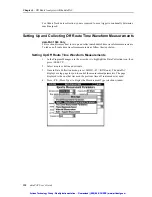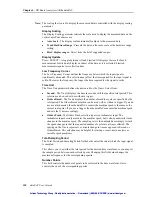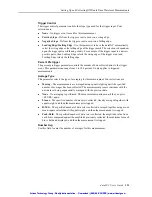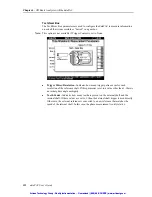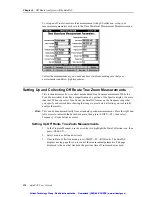
Setting Up and Collecting Off Route Orders Measurements
dataPAC User’s Guide
121
To select other views (time waveform, split screen)
1.
While collecting an off route spectrum measurement, press <F2> (Magnify) to view the
spectrum full screen.
2.
Press <F5> (Options) to open the Options menu.
3.
To exit the current window and display the reduced view window, select Reduce and
press <SELECT>.
To switch to the time waveform window, select Waveform and press <SELECT>.
To open a split screen showing both the Spectrum display and the time waveform,
choose split screen. This is especially helpful for difficult vibration problems so you
can simultaneously view and manipulate time and computed frequency information in a
real time mode.
Setting Up and Collecting Off Route Orders Measurements
This section discusses how to set up and collect unscheduled orders based/orders track
spectrum measurements. This section also contains important background information
about the difference between Orders Based and Orders Track.
Background Information about Orders Based and Orders Track
The dataPAC 1500 now supports the specification and collection of a spectrum with an
Fmax defined in terms of the number of orders for a given machine speed. With orders
based spectra, the sampling rate is not fixed during the collection period. Instead, the time
spacing between the samples may be constantly varying so that a fixed number of samples
per shaft revolution is collected. The X axis of the time waveform is no longer measured in
seconds, but instead it is measured in degrees or shaft position. From this, the corresponding
spectral information is no longer measured in Hz or CPM, but instead it is measured in
orders.
Variable speed machines are widely used in industry because of energy savings and flexible
process control. Variable speed machines operate in a speed range, rather than a fixed speed.
As a result, variable speed machines induce different vibration or resonance frequencies
during the speed increases or decreases. Furthermore, the vibration frequencies of interest
shift up or down as the speed changes, making machinery diagnosis difficult.
Rotating machines produce periodic vibrations and acoustic signals related to the shaft
rotational speed and its harmonics. For a constant speed machine, the relationship between
the vibration signals and frequency patterns can be established by the Fast Fourier
Transform (FFT) analysis. The common problems associated with the rotating machinery,
such as unbalance, misalignment, looseness, rolling-element bearing flaws, gear defects,
etc., are readily identifiable in the frequency spectrum. However, such relationship is not
always obvious in variable speed machines.
Artisan Technology Group - Quality Instrumentation ... Guaranteed | (888) 88-SOURCE | www.artisantg.com
Artisan Technology Group - Quality Instrumentation ... Guaranteed | (888) 88-SOURCE | www.artisantg.com






















